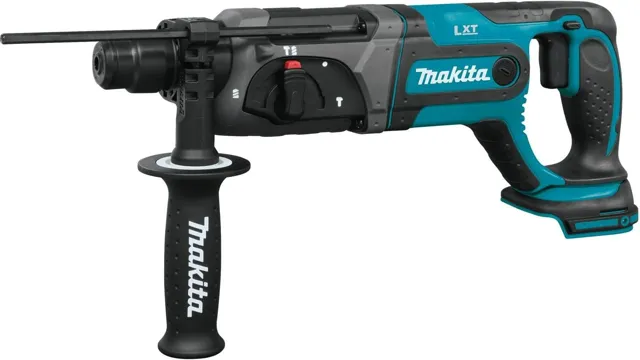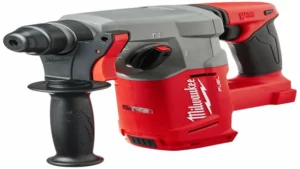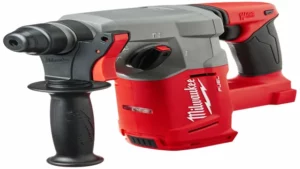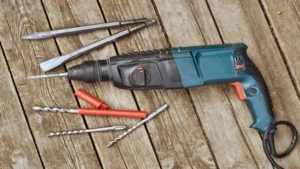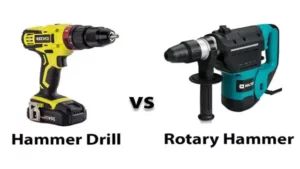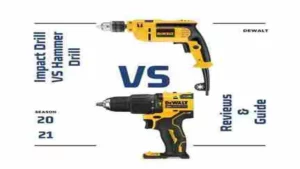If you’re anything like most people, DIY projects around the house can be quite intimidating. You may fear that you don’t have the right tools, or that you don’t know how to use them correctly. But fear not! One tool that should be in every homeowner’s toolbox is a rotary hammer drill.
This powerful piece of equipment is used for more than just drilling holes in concrete. In this blog, we’ll explore what a rotary hammer drill is and what it’s used for so you can confidently tackle your next DIY project.
Introduction
“What do you use a rotary hammer drill for?” A rotary hammer drill is a powerful tool that is used for drilling through tough materials such as concrete, brick, and stone. It provides a lot of force, making it an ideal tool for heavy-duty drilling jobs. Rotary hammer drills use a combination of rotation and hammering to break through tough surfaces, and they come with a variety of attachments that can be used for different types of tasks.
One of the most common uses for a rotary hammer drill is drilling holes for anchors or screws in concrete walls or floors. This tool can also be used for demolition work, as it can easily break up concrete or other hard materials. It is commonly used by construction workers, remodelers, and DIY enthusiasts for various projects around the home or job site.
Overall, a rotary hammer drill is a versatile tool that can handle tough drilling tasks with ease.
Defining a rotary hammer drill
A rotary hammer drill, also known as a rotary hammer or a roto hammer, is a powerful tool used for drilling through tough surfaces such as concrete, brick, and other hard materials. It is designed to deliver high impact energy to the drill bit in a rapid and continuous way, making it an essential tool for construction workers, contractors, and craftsmen alike. Whether you’re working on a home renovation project or a commercial building site, a rotary hammer drill is your go-to tool for making drilling tasks easier and more efficient.
With its ability to quickly and effectively penetrate surfaces, this tool can help you save time and effort while achieving more accurate and precise results. So, if you’re looking for a powerful and reliable tool for your drilling needs, investing in a rotary hammer drill is definitely worth it!
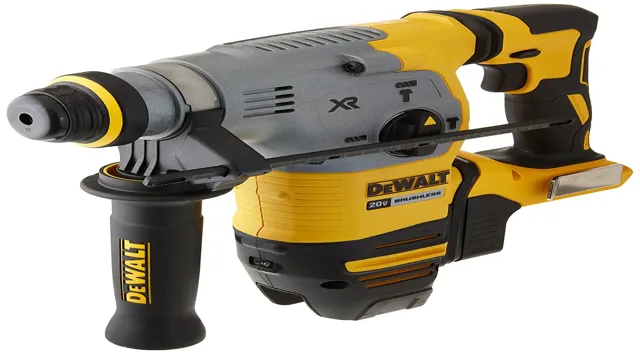
Types of rotary hammer drills
When it comes to rotary hammer drills, there are numerous types available in the market to suit various types of projects and users. The most common types include corded rotary hammer drills, cordless rotary hammer drills, SDS-Plus rotary hammer drills, and SDS-Max rotary hammer drills. Corded rotary hammer drills are typically more powerful, making them suitable for heavy-duty tasks and prolonged use.
Cordless rotary hammer drills, on the other hand, are more convenient for tasks that require mobility and flexibility. SDS-Plus rotary hammer drills are ideal for general drilling and chiseling applications, while SDS-Max rotary hammer drills are designed for more heavy-duty tasks such as drilling through reinforced concrete. So depending on your project needs, you can choose the right type of rotary hammer drill that will help you get the job done efficiently and effectively.
What It’s Used For
If you’ve ever tried to drill into a tough surface like concrete or masonry, you’ll know that a regular drill just won’t cut it. This is where a rotary hammer drill comes in handy. It’s a powerful tool that’s designed to bore through tough materials like concrete, brick, and stone with ease.
The rotary hammer drill uses a piston mechanism that combines rotation and a hammering motion to deliver precise and powerful drilling. It’s perfect for construction, DIY projects, and even tough home renovation tasks. You can use it to install electrical boxes, anchors, brackets, and all kinds of fixtures into hard surfaces.
With its power and versatility, a rotary hammer drill is an essential tool for any serious DIYer or tradesperson. Whether you’re a professional builder or a DIY enthusiast, this tool will make your drilling tasks quicker and easier than ever before. So the next time you’re faced with a tough drilling job, reach for your rotary hammer drill and get the job done in no time.
Drilling into hard materials
Drilling into hard materials is used for a variety of applications, from construction to manufacturing and engineering. The process involves using specialized tools and techniques to bore holes into materials that are difficult to penetrate, such as concrete, metal, and stone. There are several methods used to drill into hard materials, including diamond drilling, rotary drilling, and percussion drilling.
Diamond drilling, for example, uses a diamond-tipped bit to grind away at the material, while rotary drilling uses a rotating bit to bore into the material. Percussion drilling, on the other hand, uses a hammer-like action to chip away at the material and create a hole. Drilling into hard materials is an essential process that allows for the creation of durable structures and precise components.
It is used in a range of industries, such as mining, oil and gas, and construction. In the construction industry, drilling into concrete is necessary for installing pipes, anchors, and electrical wiring. In manufacturing, drilling into metal is necessary for creating precision parts for machinery and equipment.
Overall, drilling into hard materials is a vital process that has made many modern technological advancements possible.
Breaking up concrete
Breaking up concrete is a necessary task to create a level surface or clear an area for new construction. This technique involves using heavy machinery, like jackhammers or excavators, to split the concrete into smaller pieces. Breaking up concrete is commonly used in demolition projects, where the goal is to completely remove an existing structure.
It can also be useful for renovating outdoor spaces, such as removing old patios or sidewalks to install new ones. Additionally, breaking up concrete is useful for repairing damaged areas of a structure, like cracking or crumbling concrete surfaces. By using specialized equipment and careful planning, breaking up concrete can be completed quickly and efficiently, making it a common technique in construction and renovation projects.
Chiseling and demolition work
Chiseling and demolition work is a common practice in various fields. From construction to sculpture, it serves to shape or remove materials to achieve a specific design or objective. Chiseling involves using a sharp tool to carve or create rough shapes out of hard surfaces like stone, wood, or metal.
In contrast, demolition work involves breaking down existing structures to clear space or prepare an area for renovation or construction. Both are physically demanding tasks that require precision and skill to execute safely and effectively. Chiseling and demolition work may sound daunting, but they are essential for creating and maintaining the built environment.
In construction, for example, chiseling is necessary to create intricate designs on building facades or to carve out spaces for fixtures like windows or doors. Demolition work, on the other hand, is necessary for tearing down old structures to make room for new ones or removing damaged parts of a building so that it can be repaired. Without these two practices, much of the modern world we take for granted would be impossible to achieve.
In summary, chiseling and demolition work are useful tools for shaping and altering the built environment. They require skill, patience, and precision to execute successfully, but they are necessary for creating the world we live in today. So the next time you see a beautiful building or a demolished structure, take a moment to appreciate the hard work that went into creating or removing it.
How It Works
Looking at a rotary hammer drill can be intimidating if you’ve never used one before. These powerful tools are most often used for drilling into tough materials like concrete or tile. The drill bit, which is shaped like a chisel, is powered by an electric motor that provides both speed and force.
This combination of speed and force allows the drill to penetrate even the hardest surfaces with ease. In addition to drilling, the hammer function of the drill can also be used to break up materials, such as when demolishing concrete or removing tiles. Essentially, a rotary hammer drill is a powerful multi-purpose tool that can make jobs that would normally take hours or even days, quick and easy.
Hammering action
When it comes to demolition work, a hammering action can be extremely effective in breaking down tough materials such as concrete or rock. The hammering action works by repeatedly striking an object with a mechanical hammer, using either pneumatic or hydraulic power to generate the force needed for the impact. As the hammer strikes the surface, it creates a shock wave that travels through the material, breaking it apart through a combination of compression and tension forces.
This process is known as hammering or percussive action and is commonly used in construction, mining, and other heavy industries. By understanding how the hammering action works, contractors and engineers can choose the right tools and techniques to safely and efficiently demolish structures and remove unwanted materials. So, if you’re looking to take on a demolition project, be sure to consider the power of a hammering action and the various tools available to help you get the job done right.
Rotating motion
Rotating motion is a crucial aspect of many machines, devices, and systems that we use in our daily lives. It is the type of motion that occurs when an object pivots around an axis, resulting in a circular or elliptical movement. This type of motion is used in a range of applications, from simple devices like fans and electric motors, to complex machinery like turbines and engines.
The mechanism behind rotating motion involves converting one form of energy into another, such as electrical energy into mechanical energy. The most common way of achieving this is through the use of a rotor, which rotates around a central axis, transferring energy to other components in the system. Understanding the principles of rotating motion is essential for maintenance, repair, and design of mechanical systems.
By mastering this concept, engineers and technicians can create efficient and innovative machines that can perform various functions with ease, from powering heavy machinery to generating electricity for our homes.
Factors to Consider When Choosing a Rotary Hammer Drill
If you’re in the market for a rotary hammer drill, there are several factors to consider to ensure that you choose the right tool for the job. First and foremost, it’s essential to understand what you’ll be using the drill for. A rotary hammer drill is primarily designed for heavy-duty projects where a regular drill won’t cut it.
This tool is perfect for drilling through concrete, brick, and other tough materials with ease. Once you know what you’ll be using the drill for, you’ll want to take into account factors like power, speed, and ergonomics. Consider the size of the job, the type of drill bits you’ll need, and the power source.
Another crucial factor to consider is the overall weight and design of the drill. You’ll want to choose a drill that feels comfortable in your hand and is easy to maneuver. By taking these factors into account, you’ll be sure to choose the perfect rotary hammer drill for your project.
Power and size
When choosing a rotary hammer drill, two essential factors to consider are power and size. The power of a rotary hammer is measured in amps or volts, and the larger the measurement, the more powerful the tool. A high-powered rotary hammer can handle tough tasks like drilling through concrete or masonry with ease.
On the other hand, size is an essential factor to consider, especially if you are working in tight spaces. The size of the drill will determine how easily you can maneuver it and access hard-to-reach areas. If you’re looking for a tool for heavy-duty jobs, you’ll need to consider both power and size to find the best option.
Additionally, it’s crucial to think about the ergonomics of the tool’s design and how it fits your hand. Ultimately, finding a balance between power and size is crucial when selecting a rotary hammer drill that will meet your needs.
Speed and impact rates
When it comes to choosing the right rotary hammer drill, there are a few key factors to consider. One of the most important is speed and impact rates. These determine how quickly and effectively the drill can get the job done.
A high impact rate means the drill can deliver more force per blow, making it better suited for tougher materials like concrete and masonry. But speed is also important, as it helps ensure smooth, efficient drilling without bogging down or overheating. When selecting a drill, look for one with variable speed settings that allow you to adjust the speed and impact rate to match the job at hand.
This will help you get the most out of your tool and achieve the best results. So, whether you’re a professional contractor or a DIY enthusiast, keep speed and impact rates top of mind when shopping for your next rotary hammer drill.
Bits and chisels compatibility
When it comes to choosing a rotary hammer drill, there are several factors that you ought to consider in order to ensure that you’re using the right tool for your project. One of the most important considerations is the compatibility of bits and chisels. You’ll want to ensure that the bits and chisels you intend to use with the drill are compatible with the chuck size.
Another important factor is the size of the drill itself. If you’re planning on using the tool for an extended period of time, you’ll want to select one that is easy to handle and light in weight to prevent fatigue. Additionally, you’ll need to consider the voltage of the drill, and whether it’s corded or cordless.
Depending on your needs, either may be more suitable. Lastly, it’s important to consider the features of the rotary hammer drill, such as its power, speed, and vibration control. By taking these factors into account, you can select the best rotary hammer drill for your application and achieve optimal results.
Safety features
When shopping for a rotary hammer drill, it’s crucial to consider safety features. For starters, look for a model with an anti-vibration system to minimize hand fatigue and strain. Additionally, check to see if the drill has a torque limiter, which helps prevent injury and damage to the drill if the bit gets stuck.
Another important safety feature to consider is the trigger lock-off mechanism. This function ensures that the drill doesn’t accidentally switch on, preventing mishaps. As a bonus, some rotary hammer drills come with LED lights that illuminate the work area, making it easier to monitor the drilling process.
Overall, safety should always be a top priority when choosing a rotary hammer drill for any project.
Conclusion
In conclusion, a rotary hammer drill is like the superhero of power tools. It’s not just for drilling holes, but for breaking through tough materials like concrete and brick with ease. So, the next time you need to demolish a wall, install anchors, or impress your DIY friends with your power tool skills, just remember to reach for the rotary hammer drill – the ultimate weapon in your DIY arsenal.
“
FAQs
What is a rotary hammer drill?
A rotary hammer drill is a power tool that combines rotary drilling with a hammering action to break up and drill through hard surfaces such as concrete and masonry.
How is a rotary hammer drill different from a regular drill?
A rotary hammer drill is much more powerful than a regular drill, as its hammering action provides the necessary force for drilling through tough materials like concrete. Additionally, rotary hammer drills often have a chisel function for breaking up surfaces.
What size rotary hammer drill should I use for a specific job?
The size of a rotary hammer drill needed for a specific job will depend on the size and depth of holes required. It is best to consult with a professional or read the manufacturer’s recommendations before selecting a rotary hammer drill for a specific job.
What safety precautions should I take when using a rotary hammer drill?
Always wear goggles and gloves when operating a rotary hammer drill. Additionally, make sure to read and follow all safety instructions provided by the manufacturer.
Can a rotary hammer drill be used for woodworking?
While it is possible to use a rotary hammer drill for woodworking, it is not recommended as the tool is designed specifically for drilling into hard surfaces like concrete and masonry.
What is the difference between a cordless and corded rotary hammer drill?
Cordless rotary hammer drills are powered by batteries and are more portable, but may lack the power of a corded drill. Corded rotary hammer drills are generally more powerful, but limit mobility due to the need for an electrical outlet.
How do you maintain a rotary hammer drill?
Regularly clean the drill and its parts, inspect for any damage or wear, and replace any worn parts promptly. Proper storage and handling of the tool can also help prolong its lifespan.
